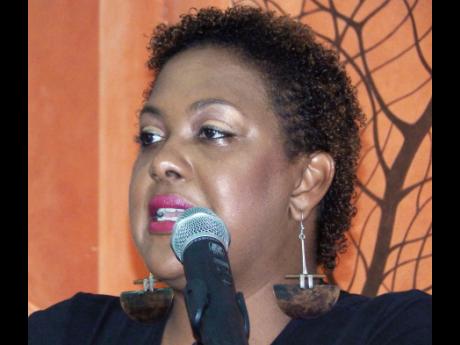Women's voices at National Gallery
Playing the guitar as she sang, Kelissa McDonald was flanked by Kadane Cespo on congas and Jason Worton on guitar, and surrounded by works of art.
She was quite comfortable in the venue, the National Gallery of Jamaica (NGJ), downtown Kingston.
As she explained to me after the recent performance, McDonald grew up in a home full of art and music.
The art came from the influence of her late grandfather, the well-known art collector A. D. Scott. The music came from her parents, who were lead singers of the reggae band Chakula.
Her parents' faith and music meant that Kelissa's music was rooted in Rastafari and reggae, she said, but it has been moderated by her education at a Los Angeles college and her travels to Africa. "We lived in the hills of St Andrew and I went to school in Kingston, but when I was 16 or 17, my family moved to Tanzania," she said.
Kelissa spent two years at college in Los Angeles and had a year's internship in Ghana pursuing a major in African studies (which included the study of art and dance) and a minor in music. She was also in Ethiopia for a while, but returned to Jamaica upon graduation in 2011.
"Since then, I've made music my career. Before, it was a hobby," she told me.
Her annual November show, Kelissa Live, is mounted at a venue on Skyline Drive. Otherwise, she does freelance gigs with her band, the Ambessadors. "I usually play with a band, but occasionally I play (the guitar) on my own," she said. "I write my own songs, lyrics and music."
At college, Kelissa studied the piano and taught herself to play the guitar, finding that instrument more suitable for the "positive and uplifting music" she composes. She confessed she writes "a lot of love music", but doesn't do much of it in her gigs. This is because "it's expected of women", she said, laughing.
Her social commentary songs "may come across as revolutionary", Kelissa admitted. She has an album in the making.
What took me to the National Gallery that day, Sunday, May 31, was an invitation to the gallery's Last Sundays series, which generally features an art exhibition and a performance of some sort. The exhibition, Explorations 3: Seven Women Artists, will run until August 8.
mid-career artists
The exhibition is the third in a series which continues to explore some large themes and issues in Jamaican art, asking whether the label 'women's art' is relevant in Jamaica today. It features the work of Jasmine Thomas-Girvan, Judith Salmon, Miriam Hinds-Smith, Prudence Lovell, Kereina Chang Fatt, Berette Macaulay and Amy Laskin, seven mid-career artists who are based in Jamaica or of Jamaican origin.
Kelissa and her band were the official performers that day. However, the address by the guest speaker, poet and University of the West Indies, Mona, lecturer Tanya Shirley, elicited so much laughter that it could well be called a performance.
Shirley spoke about the roles, perceived and real, of female artists, a topic which resonated with the theme of the exhibition. According to NGJ senior curator O'Neil Lawrence, the exhibition invites viewers "to explore whether there are any commonalities that set these artists' works and careers apart from those of their male counterparts and whether there is any justification to label them as 'women artists'".
Shirley said that, after all these years, women are still judged by the traditional roles of wife, mother and housekeeper and female artists creating in an environment like Jamaica's are "constantly aware of the politics of going against the grain". In fact, she continued, the exhibiting artists' "audacity" in exhibiting after "spending countless hours creating art" runs the risk of being seen as "bad women".
She said that, just as in the United States, women are often told they must work twice as hard as men to succeed in the businessplace. In Jamaica, the female artist has to work twice as hard to claim and maintain her space as an artist. Therefore, when a woman produces art, she said, "It is, in many ways, a rebellious act."
Before concluding with a poem, Shirley said, "What the exhibition reminds us of is that there are many accomplished female artists doing groundbreaking work in our country and their names deserve to be on the tips of our tongues. I embrace the artists in this exhibition for being rebellious and behaving badly in a man's space."
Shirley's poetry may be found in journals such as Small Axe and The Caribbean Writer and in New Caribbean Poetry: An Anthology and So Much Things to Say: 100 Calabash Poets. Her own poetry collections are She Who Sleeps With Bones (2009) and The Merchant of Feathers (2015).
The gallery's executive director, Verlee Poupeye, welcomed the audience.
This Sunday afternoon at the NGJ, the second poetry collection by Millicent A. A. Graham, The Way Home, will be launched. There will be readings by Graham herself, actress-broadcaster Leonie Forbes, and poets Jean Binta Breeze and Yashika Graham.




